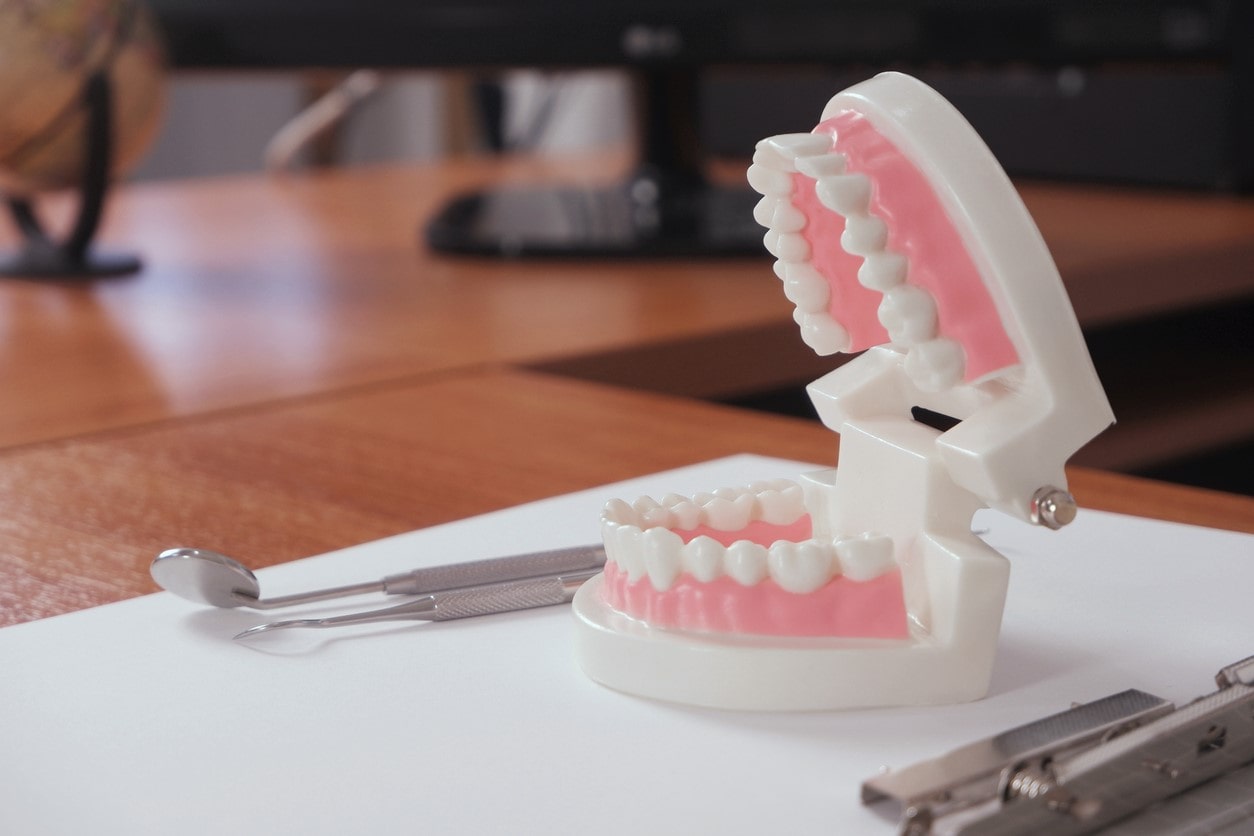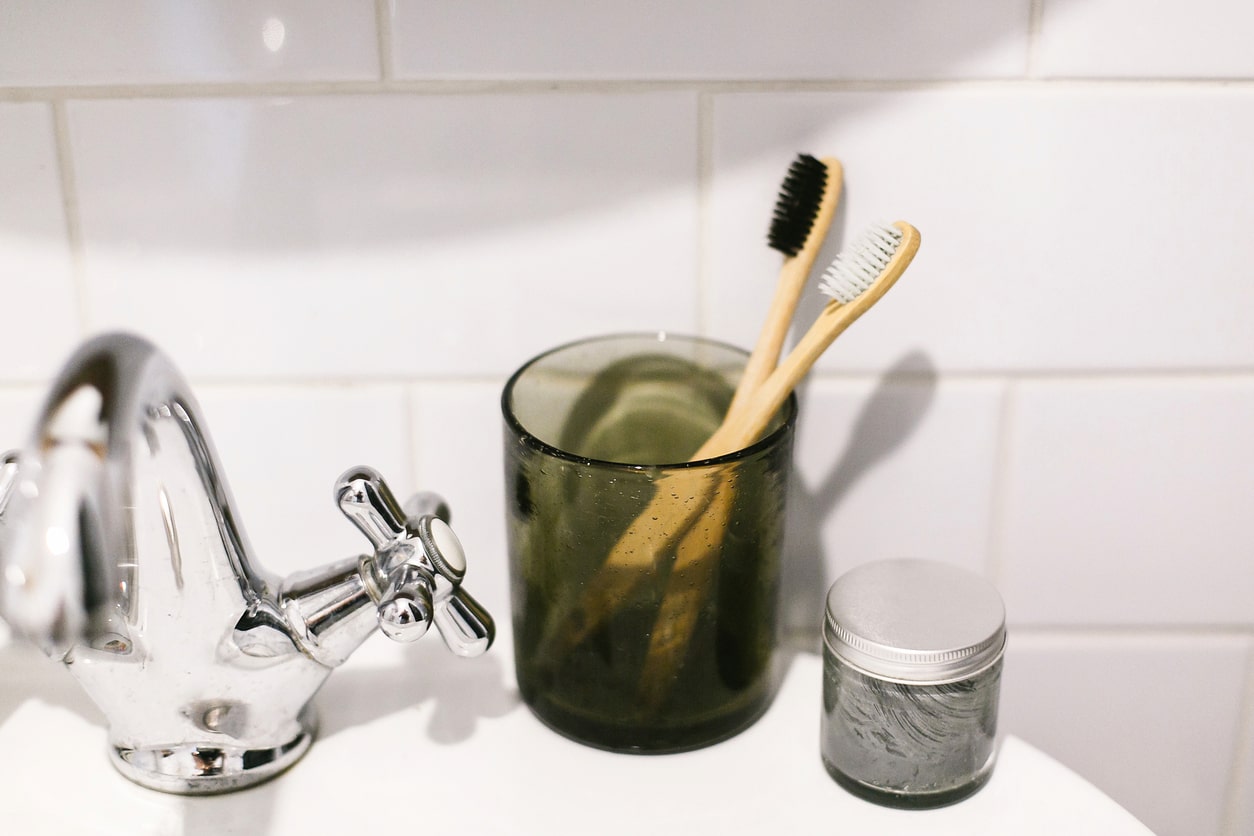Has your jaw been clicking or popping? Are you wondering why? We’ve got you covered with some information below that might help you figure out what’s going on.
Continue reading to learn more, but keep in mind: seeing your dentist is the best way to get an accurate diagnosis and proper treatment to resolve any issues you’ve having with your jaw.
First, We Need to Talk About TMD
TMD is short for temporomandibular joint disorder and can also be referred to as TMJ. You might have heard of it, but you might not know exactly what it is.
Put simply, TMD is a condition that affects the temporomandibular joint. That’s the hinge on either side of your face that connects your jaw to your skull. When you open and close your mouth, it’s this jaw that works, and it also allows you to move your jaw backward and forward, as well as side to side.
Want to find this joint? Place your fingers in front of your ears and open and close your mouth. Feel it? Neat, right?
So, when you have TMD, a problem arises within this complex and important joint, causing symptoms like discomfort, pain, clicking, or popping. And the disorder can make it difficult to do simple things like chew your food, talk, and even yawn. Ouch!
What causes TMD? Well, it’s sometimes hard, even for dentists, to figure out the root of the problem. There are a variety of things that can contribute to this disorder, and they include trauma, malocclusion, arthritis, and bruxism (clenching and grinding the teeth), as just a few examples.
Is Your Clicking Jaw a Symptom of TMD?
If your jaw is clicking but you aren’t experiencing any pain, and you aren’t experiencing any limitations when opening and moving your jaw, it might not be TMD. Even occasional discomfort in the muscles or joint may not be anything serious, and the clicking might come and go as well. That’s good news!
Clicking in your jaw might be mild and temporary, lasting only a little while before going away on its own. If you’re having more severe or ongoing symptoms, however, a more serious issue, or TMD, might be to blame.
What Can You Do to Relieve Clicking in the Jaw?
There are some things you can try at home to help stop your jaw from clicking and popping. Here are some examples:
Avoid chewing gum, and avoid foods that are crunchy, hard, or chewy, as these can all put excess strain on the jaw and make the popping and clicking worse. Take small bites so you don’t have to open your jaw as wide and try to stick with soft foods until your jaw issues resolve.
Massaging and stretching the muscles of the face and jaw might help you get rid of the clicking you’re experiencing, but this is best done with the help of a physical therapist, doctor, or dentist.
Feeling stressed? Clenching your jaw because you’re tense? Try stress-relieving strategies like deep breathing, meditation, and exercise. You can even make it a point to relax your jaw by keeping a bit of space between your upper and lower teeth.
Remember, if the discomfort you’re feeling persists, or if you notice that you aren’t able to open or close the jaw properly, it’s best to see a dental professional who can pinpoint what’s going wrong with your jaw.
Jaw Symptoms? See Your Dentist for Advice!
Even though a painless clicking in your jaw might not be anything to worry about, it’s still a great idea to make an appointment with your dentist for a checkup. He or she can examine your jaw and take X-rays to evaluate the health of your temporomandibular joint. If it’s determined that you have TMD, you can start receiving the appropriate treatment to get relief, based on the cause of the problem.
Concerned about being able to afford trips to the dentist for symptoms like clicking or popping sounds in your jaw? The right dental insurance can help! Search for the ideal plan on the Direct Benefits Marketplace, where you’ll find comprehensive coverage that will give you peace of mind.
Sources:
https://www.colgate.com/en-us/oral-health/temporomandibular-disorder/when-a-clicking-jaw-is-a-sign-of-tmd
https://www.mayoclinic.org/diseases-conditions/tmj/symptoms-causes/syc-20350941
https://www.medicalnewstoday.com/articles/319888#treatment-for-jaw-popping
http://www.tmj.org/site/content/tmd-basics
DENTAL BLOG
You already know that brushing and flossing daily and seeing your dentist regularly for professional cleanings are smart ways to remove plaque and tartar. By taking these steps to keep your teeth and gums clean, you’re helping to reduce the odds of developing cavities. Great work!
But you can do even more to protect your pearly whites. Go beyond brushing with fluoride toothpaste by talking to your dentist about fluoride treatments and the benefits that they can provide.
What are fluoride treatments, and why might you need one? Check out the information below to learn more, but also be sure to chat with your dentist to find out if this option would really be right for you.
Would You Benefit from a Fluoride Treatment?
When you see your dentist for a checkup, they might be able to determine your level of risk when it comes to cavities. If you have a high or moderate risk of cavities developing, a professional fluoride treatment might be a great preventive measure to take—in addition to following a strict oral hygiene routine at home, of course.
Some factors that may indicate you’re the right type of patient for a fluoride treatment. These include:
Weakened enamel, enamel defects, or exposed root surfaces
Dry mouth
High amounts of bacteria that can cause cavities
Poor oral hygiene
Poor diet
How Does It Work?
You might be wondering why you would need to receive a fluoride treatment in the dentist’s chair if you’re already using toothpaste and mouthwash that contain fluoride. Well, it’s simple: the fluoride that’s used by your dentist will be more highly concentrated, making it even stronger than what you’re getting daily at home through brushing and rinsing.
If your dentist notices the early signs of tooth decay—when you don’t yet have a cavity that requires drilling and filling—treatment that applies strong fluoride directly to a tooth might help prevent the decay from progressing, and might even reverse it! And, in children, fluoride treatments may help prevent decay in those adorable baby teeth, too.
Basically, the fluoride gets to work on rebuilding your enamel. It can do that by helping the teeth absorb calcium and phosphate from your saliva. Fluoride might also get in the way of bacteria that could lead to cavities, making it harder for that bacteria to stick to your teeth and do damage.
What to Expect When Getting a Fluoride Treatment
Along with helping prevent cavities, the best part about fluoride treatments is that it’s painless and simple – the treatment only takes a few minutes to complete!
Here’s how easy it is: your dentist will apply the fluoride, which could be in the form of a gel, a rinse, a foam, or a varnish. They might use a brush, cotton swab, or tray to carefully apply the fluoride to your teeth.
After the fluoride is applied, you might be told that you aren’t allowed to drink or eat anything for a certain amount of time, typically about a half-hour, so the solution can get to work strengthening your teeth.
How often do you need to get a fluoride treatment? The answer depends on various factors, and your dentist will decide what’s right for you. Some people might need a fluoride treatment once a year, while others might need one every few months.
Fluoride Treatments: Painless, Fast, and Worth Talking to Your Dentist About
Overall, fluoride treatments may be an option if you’re at a higher risk of getting cavities, as this simple, painless, and quick treatment might help you avoid the dentist’s drill. Who wouldn’t want that?!
If you think that you could benefit from a fluoride treatment, talk to your dentist. And, remember, if you have the right dental insurance, like one of the high-quality plans on the Direct Benefits Marketplace, you can rest assured that you’ll be able to receive the oral health treatments you need without breaking the bank in the process.
Sources:
http://www.ada.org/~/media/ADA/Member%20Center/FIles/patient_72.ashx
https://www.colgate.com/en-us/oral-health/fluoride/fluoride-treatments
https://www.medicalnewstoday.com/articles/327168#benefits
https://phys.org/news/2013-05-evidence-fluoride-tooth.html
https://www.npr.org/sections/health-shots/2016/03/14/469959427/no-drill-dentistry-fluoride-treatments-can-prevent-cavities-in-adults
https://www.healthychildren.org/English/healthy-living/oral-health/Pages/Fluoride-Varnish-What-Parents-Need-to-Know.aspx
When it comes to replacing missing teeth, two well-known options are dental implants and dentures. But there are pros and cons associated with each, so before you decide which one of these is best for you, keep reading to learn more about them{...}.
What You Need to Know About Dentures
Pros
Today’s dentures are better than those of the past, and they are a rather simple solution when you need to replace some or all your teeth. They tend to be inexpensive, particularly when compared to dental implants, and you don’t need to undergo an invasive procedure to get them.
The key is to be sure you see a dental professional who will ensure your dentures are made correctly. When they are properly fitted to your unique mouth, they will be less likely to get in the way of your speech or slip out of place. And, in the case of partial dentures, they’ll be less likely to cause infection or tooth decay in nearby teeth.
Dentures also might be the ideal option if your jaw or gums aren’t in the best shape and, therefore, would not be able to support implants.
Cons
One of the drawbacks of dentures is that they are removable, and they might need to be secured into place with a special adhesive. They also need to be cleaned when you take them out of your mouth.
Even when in place, dentures might not function like real teeth because they aren’t secured into your jaw. Complete dentures might be uncomfortable, they might make your gums sore, and they might even affect the way you taste food. And when you do things like cough, smile, speak, chew, and yawn, the dentures might even shift or click.
Finally, dentures might last up to 15 years, and they may need to be adjusted if your gums and facial structure change as you get older. Therefore, you’ll need to factor in the cost of replacing them whenever necessary.
What You Need to Know About Dental Implants
Pros
You can get a single dental implant, or you can have all of your teeth replaced with implant-supported dentures. Provided that your jaw and gums are healthy enough, dental implants can serve as a long-term solution to missing teeth. With proper care, they might even last a lifetime!
Because they’re surgically implanted into the jawbone, implants are more comfortable than dentures. They look and function just like real teeth, so they don’t get in the way of your speech or your ability to chew and taste food. You can even brush and floss them, just like your natural teeth, to keep them clean.
Also, unlike dentures, because implants are placed into the jaw to replace tooth roots, the bone will be less likely to deteriorate over time. This can help prevent problems like facial sagging and changes to your smile.
Cons
One of the biggest drawbacks of getting a dental implant is the fact that this is a surgical procedure that requires multiple steps. As a result, implants are much more expensive than dentures, typically costing thousands of dollars.
You will need to undergo an invasive procedure to get a dental implant. Additional steps, such as having X-rays taken, are necessary, and some patients also need a bone graft as well.
The entire process of getting implants is typically completed over the course of several appointments, and you might experience pain along the way.
No Matter What You Decide, the Right Dental Insurance Can Be Really Helpful!
Whether you opt for dentures or implants will depend on a variety of factors, including your dentist’s recommendations, but no matter which solution you go with, having dental insurance can put your mind at ease when it comes to paying for these services.
Pro tip: Be sure to read the fine print to see if implants are covered if that’s the route you’d like to take to restore your smile. Not all dental insurance policies will help cover their cost.
To find the ideal dental plan to suit your needs and expectations, check out the Direct Benefits Marketplace, where you can easily compare plans and sign up for one whenever you’re ready. Then, you don’t have to worry about breaking the bank if you need dentures or implants!
Sources:
https://oralb.com/en-us/oral-health/life-stages/adults/implants-vs-dentures/
https://www.acfdga.com/blog/2018/9/6/should-i-get-dental-implants-or-dentures-heres-your-answer
https://www.aaid-implant.org/dental-implants/implants-vs-dentures-and-bridges/
https://www.perio.org/consumer/full-mouth-implants
https://forestparkdental.com/dental-implants-vs-dentures-best-2/
Ready to purchase dental insurance? Great! This is a really smart step to take, as oral care can be expensive.
The right insurance will help cover the costs so you never have to miss an appointment for a checkup, cleaning, or treatment that will keep your smile bright and beautiful. As you begin shopping for dental insurance, though, you might quickly become overwhelmed. How can you sort through all of your options to find the one that will suit your needs, as well as your budget?
We’re here to help with this handy dental insurance guide. Below, we cover the basic things that you should look for in a plan, as well as factors to consider to help you land on the ideal policy for yourself and your family.
Details You Should Look for
Out-of-pocket costs – In addition to your monthly premium, find out what other out-of-pocket costs you’ll be responsible for. These might include a deductible, co-insurance, and copay.
Annual maximum – A dental insurance plan will only cover up to a certain amount per year, so be sure to check what the annual max is. If you think you need more coverage for various treatments, you’ll want the annual maximum to be higher. Once that maximum number is reached, you’ll have to cover the rest on your own.
Waiting period – Is there a waiting period before the insurance kicks in? If a plan doesn’t have a waiting period, it means you can begin using it right away.
The network – If you want to be able to continue using your current dentist, you’ll want to ensure you can do so. Some dental plans, such as HMO and PPO options, have networks of providers that you must adhere to. Others, such as indemnity plans, will allow you to choose any dentist you want.
Ask Yourself: What’s Covered by Various Dental Plans in Your Area?
Not all dental plans will cover the same types of services, and some will be more comprehensive than others.
As you look through the various dental insurance providers that are available in your area, check if their plans cover a wide range of services, such as the following:
Preventive and routine care like exams, cleanings, sealants, fluoride treatments
Diagnostics like X-Rays
Treatments for the gums, such as root planing
Fillings, root canals, extractions
Crowns, dentures, bridges
Dental implants
Orthodontics
Emergency services
Oral surgery
Cosmetic procedures like whitening treatments or veneers
Note: These services might not be covered 100%. If that’s the case, consider your out-of-pocket costs if you were to seek out these treatments.
Other Things to Consider Before Choosing a Plan
By now it’s clear that when you’re shopping for dental insurance, you have to look at a lot more than just the monthly premium that you’ll be required to pay. But there’s more. Here are some other things to keep in mind as well:
Will the plan cover everything you need for yourself, as well as your spouse and kids if they also need coverage?
What level of customer service does the insurance company provide? Is it easy to get in touch with them when you have questions or concerns?
Does the policy limit you to the cheapest treatment options available? In other words, if you opt for more expensive treatments, will you still be covered or will you have to pay for those out-of-pocket?
Want an Easier Way to Shop? Check out the Direct Benefits Marketplace!
Head to the Direct Benefits Marketplace to view the dental plans that are available in your area. You can compare different policies side-by-side to clearly see what they have to offer, and you can get a better picture of what your out-of-pocket costs will be based on the level of coverage that’s provided by each insurer.
Once you start looking at what options are available, you might be surprised by how many choices you have, and how affordable they are. And with the information above, you can take additional steps to rest assured you’ll select the plan that’s just right.
Sources:
https://www.dentalplans.com/dental-information/dental-insurance/how-to-choose-dental-insurance
https://www.webmd.com/oral-health/guide/dental-health-insurance#1
https://www.ahip.org/wp-content/uploads/2015/06/Guide_to_Dental_Insurance.pdf
https://www.investopedia.com/articles/personal-finance/120914/4-important-steps-choosing-dental-insurance.asp
http://www.insuranceqna.com/dental-insurance/choosing-a-dental-plan.html
Toothaches hurt! And when you have one, you want to get relief fast. But if you're not a fan of using products with synthetic ingredients, you might be in search of natural remedies to try instead. We've got you covered!
There are several natural remedies for teeth pain that you can use to reduce the discomfort until you can see your dentist.{...} We've listed a few of them below to help you get started.
Natural Remedies to Try:
1. Apply a Cold Compress to Your Cheek
This natural option can be helpful if you have swelling along with a toothache. Just take a cold compress and put it against your cheek for 20 minutes. If you need more relief, wait an additional 20 minutes before reapplying the cold compress to the outside of the cheek. The goal here is to temporarily bring the swelling down, while also numbing the pain in the tooth.
2. Feel Better with Clove Oil or Peppermint Oil
Clove oil is a natural pain reliever, but it can also help with swelling. Start by absorbing several drops of clove oil with a cotton ball. Rub it gently over the gums and teeth that are causing discomfort. Just keep in mind that, like other remedies on this list, this one can provide temporary effects, but you might be surprised by how well this oil works.
Another natural way to numb the pain would be by using peppermint oil to get short-term relief. Once again, you can apply it using a cotton ball. Soak up a few drops of peppermint oil with a cotton ball, and then apply it to the painful area in your mouth.
3. Numb the Pain with Peppermint Tea or Black Tea
If you don’t have peppermint oil, you can also use peppermint tea. Take a teaspoon of dried peppermint leaves and steep it for 20 minutes in a cup of boiling water. Once it cools down, use this as a rinse by swishing it around in your mouth. You can either swallow it or spit it out.
Don’t have peppermint tea? No problem! Grab some black tea instead, which is also capable of reducing pain and swelling. To make the most of this natural remedy, you’ll need a wet tea bag (warm is most comfortable). Simply put it against the tooth that’s aching to help relieve the discomfort temporarily.
4. Rinse Your Mouth with Salt Water or Hydrogen Peroxide
Warm salt water can serve as a pain-relieving mouth rinse when you have a toothache and swelling in the gums. Put anywhere from ½ teaspoon to 2 teaspoons of salt in a cup (8 ounces) of water and swish it around for about 30 seconds before spitting it out. Make sure the water is warm, rather than hot or cold, as that will provide the most relief without causing more discomfort.
Alternatively, you could try rinsing your mouth with hydrogen peroxide to reduce pain and swelling. Mix a small amount of 3% hydrogen peroxide in an equal amount of water before swishing and spitting. Like the salt water rinse, this shouldn’t be swallowed. And, after spitting it out, rinse your mouth a few times with pure water.
Have a Toothache? Make an Appointment to See Your Dentist!
Toothaches and swollen gums shouldn’t be ignored. If you’re experiencing these symptoms, it’s time for a checkup. So make an appointment with your dentist to figure out what’s going on, and to receive the appropriate treatment that will provide permanent relief.
Worried about affording trips to the dentist? Then consider signing up for one of the many affordable dental insurance plans on the Direct Benefits Marketplace! With the right plan, you’ll receive the financial support you need to keep your teeth and gums strong, healthy, and pain-free.
Sources:
https://www.webmd.com/oral-health/home-remedies-toothache
https://www.thehealthy.com/dental/home-remedies-for-toothache/
https://www.colgate.com/en-us/oral-health/adult-oral-care/4-tooth-pain-home-remedies
https://www.colgate.com/en-us/oral-health/cavities/four-homemade-toothache-remedies
Like all other parts of your body, your teeth will change with age. And, as you get older, you need to be extra diligent when it comes to preventing oral infections, tooth decay, and gum disease.
Knowing how your teeth change as you get older and understanding what you can do to keep them as strong and healthy as possible will help you maintain your beautiful smile as you get older.{...} Remember, if you start taking steps today to keep your mouth healthy, you can reduce the odds of needing to replace your natural teeth with dentures or implants in the future.
How Teeth Change as You Get Older
Here’s a list of some of the ways that you can expect your chompers to change with each passing year:
• Wear-and-tear takes its toll on your enamel: Years and years of biting and chewing might eventually wear down your enamel, which is the outer layer of the teeth. Even certain foods, such as those that are acidic, could do damage. Also, certain parts of the teeth may become flatter over time. Plus, bruxism (teeth grinding and clenching) and a poor bite might also wreak havoc on the surfaces of your teeth. Bad habits like chewing on hard foods or ice, could make your teeth more susceptible to damage, too.
• Increased sensitivity: As you get older, and your enamel is worn away more and more, or your gums begin to recede, you might start to experience sensitivity, particularly when you eat or drink something cold or hot. If your teeth are sensitive, be sure to see your dentist to rule out problems like gum disease or tooth decay.
• Less sensitivity because of changes in the nerves: Your teeth have nerves inside them, and they might get smaller as you get older. This could make you less sensitive to problems like cavities, so you might end up going a long time with decay eating away at your pearly whites if you don’t see your dentist regularly for checkups. Reduced sensitivity also means that you might not notice if there’s a small break in a tooth that ends up exposing the inner pulp. Your dentist can catch problems in their earliest stages at regular exams and cleanings, so be sure to keep those dental appointments even if you don’t have any symptoms!
• Your teeth won’t be as white: As you get older, your teeth may not look as white and bright as they used to. The dentin might become more obvious through the enamel, which can also become stained by what you eat and drink.
The Risk of Problems Increases with Age
As you get older, your risk for a variety of oral health problems, from cavities to cancer, increases, and the gums start to recede as well.
Unfortunately, once you’re over 65 years of age, the odds of tooth decay developing and the odds of needing a root canal for severe damage are much higher than when you’re younger.
Additionally, if you have old fillings from many years ago, you’ll need to see your dentist to ensure they aren’t breaking down and decay isn’t occurring along their edges. Your dentist can fix these problems if they arise.
Keep Your Gums Strong to Support the Health of Your Teeth
Did you know that gum disease is the main cause of tooth loss in seniors? So, if you want to keep your teeth healthy as you age, it’s important to take great care of your gums, which provide the foundation for your pearly whites.
Brushing, flossing, and professional dental cleanings can help you prevent the buildup of plaque in between teeth and along the gum line. Remember: even if you’re brushing and flossing regularly at home, you might not be getting your teeth as clean as they should be, so professional cleanings in the dentist’s chair can help prevent a minor case of gum disease from becoming worse as you get older.
See your dentist regularly for checkups and let them know if your gums bleed, or if they feel swollen or sore at all. A dental professional will be able to carefully evaluate the health of your gums, looking for areas that might be receding and putting your teeth at risk. Luckily, there are a variety of treatments available to resolve gum disease before it can do serious damage to your teeth.
Have the Right Dental Insurance to Help Cover the Costs of Care!
Cleaning your teeth and gums at home, and seeing your dentist for checkups, are important steps during every stage of life, but they become even more important when you’re older. Shopping for the right dental insurance can help put your mind at ease when it comes to affording the professional care you need to keep your smile looking fabulous, no matter your age.
If you’re ready to sign up for a dental plan, check out the Direct Benefits Marketplace to easily compare options that are available in your area.
Sources:
https://www.webmd.com/oral-health/teeth-gums-age#1
https://www.health.harvard.edu/diseases-and-conditions/the-aging-mouth-and-how-to-keep-it-younger
https://www.mouthhealthy.org/en/az-topics/a/aging-and-dental-health
Dental insurance companies want you to buy their plans rather than a competitor's-Not so surprising, is it? But, as you shop for a dental policy, it's important to look beyond buzzwords and focus on the fine print. That way, you'll be able to see what a plan really has to offer, and you can be confident that you're making the right choice after comparing your options{...}.
How can you be sure you’re picking the best dental insurance for your needs? We’ve compiled some tips to help you get started.
Think About Your Current and Future Needs
While you can’t predict every dental treatment you’ll need (think: accidentally chipping a tooth) or the costs associated with high-quality care, it is possible to get a general idea of what you and your family will need, both now and in the future.
• Regular checkups are necessary to keep an eye on your oral health. Your dentist can look for early signs of gum disease and cavities, and then you can get less invasive, more affordable treatment.
• Cleanings, too, are a key component to maintaining your oral health for years to come. Brushing and flossing at home every day is great, but it won’t get rid of all the plaque and tartar on your teeth. A dental hygienist knows exactly what to do to clean your teeth to help keep problems at bay.
• Another component of oral health maintenance: getting X-rays. These will allow your doctor to see inside your teeth and determine if there’s any decay or infection.
Beyond routine care, there are many other possibilities to think about, as these will also play a role in determining the type of insurance policy you’ll need. Some examples:
• Do you have kids? They might end up needing orthodontics to correct a bite or to straighten their teeth for a perfect smile.
• Are you and your spouse getting older? Did you know that, as you age, your risk of various oral health problems increases? Having a comprehensive dental plan that covers extras like dentures can help put your mind at ease, especially when it comes to affording care while following a strict budget.
• Have you always had problems with your teeth, despite your efforts to brush and floss at home? You might end up needing more fillings, or you might need expensive root canals and crowns at some point in the future.
• If you ever lose one or more teeth due to any reason, replacing missing teeth with bridges and implants is a great way to get your smile back, but these options can be costly without the right insurance.
Evaluate Plans Based on What They Cover
Now that you’ve thought about some of your current dental care needs, as well as your potential future needs, you have a clearer idea of what you require from your insurance.
For example, if you don’t have kids or you aren’t planning on having any children, you might decide that you don’t want to spend money on a plan that includes coverage for orthodontics.
Or, if you want to stick with a basic plan to cover routine care because your teeth and gums have always been healthy and strong, you might opt to look for affordable plans that don’t have a lot of extras.
On the other hand, if you’re the type of person who wants the peace of mind that comes with a more complete package that includes even the most expensive treatments (because you never really know what will happen), you’ll know to look for plans that cover it all.
Pro Tip: Not all dentists work with every insurance company or plan. If you have a dentist that you really like, and you don’t want to be forced to switch, ask their office what insurance plans they accept so you can select one that includes your dentist in their network.
Comparing Plans Doesn’t Have to Be Challenging
Now that you know how to evaluate your needs to determine what type of dental insurance would be right for you and your family, it’s time to shop!
Remember, when comparing policies, look for information regarding the level of coverage for preventive care (like checkups, cleanings, and X-rays), basic care (like fillings), major care (like bridges, crowns, and implants), and emergency care.
Orthodontic care would also be listed as a separate category to look for if you need it.
To begin your search, check out the Direct Benefits Marketplace. You can view dental plans available in your area, and you can narrow down your options to those that are designed for single individuals, kids, and families with or without kids.
On the Direct Benefits Marketplace, you also get to compare several plans side-by-side to see what your out-of-pocket costs will be, and what percentage of coverage you’ll receive in every dental care category. This makes shopping for your specific needs super easy! Get started whenever you’re ready, and before you know it, you’ll have the coverage that can help keep your teeth and gums in tip-top shape.
Gingivitis-characterized by gums that bleed and are swollen, red, and sore-is the earliest stage of gum disease.
Even though you might get a little freaked out by this diagnosis, rest assured that it is reversible. You can get your gums back to a state of health rather easily, without the need for expensive treatments. But you do need to put the work in to do it right, and to prevent this condition from progressing into serious gum disease{...}.
Below is some information on how to reverse gingivitis, but be sure to work closely with your dentist for personalized guidance on how to heal your gums and keep them strong for years to come.
You Can Tackle Gingivitis at Home
First off, whenever you’re experiencing symptoms, it’s best to see your dentist to get answers. If the diagnosis is gingivitis, here are some steps you can take at home every day to reverse it and keep it from coming back:
1.Brush and floss every single day: To keep your pearly whites bright and your gums gingivitis-free, brushing and flossing daily is necessary. There’s no way around it. Brush at least twice a day for two minutes at a time using a manual or electric toothbrush with soft bristles that won’t irritate your gums. Brush along the gum line, and replace your toothbrush regularly. Floss at least once daily with string floss or a water flosser to clean between your teeth. This simple routine can help ensure you remove plaque and bacteria that would otherwise irritate the gums.
Note: When it comes to maintaining gum health, flossing is a must, so don’t forget to
do it.
2. Add a mouthwash and/or oil pulling to your routine: In addition to brushing and flossing, your dentist might recommend adding a mouthwash to your routine in order to reverse gingivitis. Ask your dental care provider which type of mouthwash would be best for your needs. Plus, you might want to try oil pulling with coconut, sunflower, or sesame oil, as this simple technique may help reduce plaque that causes gingivitis.
3. Eat a healthy diet that supports gum health: Your oral health can be affected by what you eat, so consuming plenty of foods that are nutrient-dense, while avoiding sugary and starchy foods, is wise. Stick with whole grains, add more fruits and veggies to your diet, and switch to water if you drink a lot of carbonated and sugary beverages.
4. Treat dry mouth: If you’ve been diagnosed with dry mouth, there’s less saliva to help keep bacteria from wreaking havoc on your gums, so it’s wise to take steps to keep your mouth moist. Your dentist can give you tips on how to go about doing so, but you might find relief with simple strategies like chewing sugar-free gum, enjoying sugar-free lozenges, and drinking more water.
5. Quit smoking: Smoking is an unhealthy habit for many reasons, but a lot of people don’t realize that it can also take its toll on your gum health, and make it harder to heal from gingivitis too. Quitting smoking might be your ticket to reversing gingivitis and preventing gum infections.
Your Dentist Can Help!
Great oral health includes both home care and professional care, so see your dentist regularly for checkups and professional cleanings, which go a long way in preventing and reversing gingivitis.
Why are professional dental cleanings so important when it comes to reversing gingivitis? It’s pretty simple: tartar isn’t something that you can get rid of on your own, no matter how impeccable your oral hygiene routine is. By getting rid of that tartar buildup, a dental hygienist can help restore the health of your gums.
How often should you see your dentist? Well, experts recommend every six months, but your dentist can tell you whether or not you can go longer between visits or if you need to see him or her more often.
It’s Possible to Reverse Gingivitis and Prevent Future Problems!
The ultimate goal is to keep as much plaque, tartar, and bacteria off of your teeth as possible so your gums can remain healthy and strong. And you can do that by following a strict oral hygiene routine at home, while also seeing your dentist regularly.
Experiencing symptoms? See your dentist as soon as possible for a proper diagnosis. If it’s gingivitis, he or she can professionally clean your teeth and give you a plan to follow to get your gums back to a state of health. With consistent effort, it might even only take a couple of weeks to start seeing results. Then, just maintain this routine so you can prevent gingivitis from recurring.
Final Tip: Worried about affording professional dental care? Browse the Direct Benefits Marketplace to find the perfect insurance that can help cover the costs so you never have to skip an appointment, especially when you’re experiencing gum problems.
Sources:
https://www.colgate.com/en-us/oral-health/gum-disease/reverse-gum-disease-dont-miss-your-window-of-opportunity
https://www.waterpik.com/oral-health/edu/gum-disease/how-long-does-gingivitis-take-to-heal/
https://www.webmd.com/oral-health/gingivitis-gum-11#1
https://benefitsbridge.unitedconcordia.com/reversing-gingivitis-7-tips-to-make-it-happen/
https://misuse.ncbi.nlm.nih.gov/error/abuse.shtml
Dental implants are great. They look and function just like real teeth, so they are a popular option when it comes to replacing a missing tooth. Unfortunately, dental implants can be pricey.
To better understand the costs associated with this procedure, and to access other important information that can help you make the right decision for your dental health, check out the short guide below.{...}
How Much Do Dental Implants Cost?
The thing about dental implants is that their cost is determined by a variety of factors, such as:
Where you are located, and the dental professional you select
Whether or not you’ll need to have a tooth extracted first
Whether or not you’ll need a bone graft
How many dental implants you need
The materials used for the implant and crown
Because of all of these variables, it’s hard to say exactly how much a dental implant will cost. You can, however, expect that it will be expensive.
How expensive?
Well, if you’re just getting one implant to replace a single tooth, it might cost you anywhere from $1,500 to a whopping $6,000.
If you’re replacing up to four teeth, your costs might be as high as $10,000.
Full mouth dental implants, also known as implant-supported dentures, cost $34,000, on average, though the price might be even higher than that.
Why Are Dental Implants So Expensive?
Now that we’ve covered the range of prices that you might see when you’re looking into getting dental implants, it’s time to cover why they’re so expensive.
First off, dental implant surgeries need to be performed by trained and experienced professionals. You’ll likely need to make several appointments with the dental surgeon, and you’ll also need to cover the cost of X-rays or a CT scan of your mouth before you even get started.
Dental implant surgeries are complex, and involve multiple steps and trips to the dental chair. Generally, those steps include moving through an initial consultation, as well as the procedure to place the implant into the jawbone. You’ll then need to have the abutment placed after the gums heal, and then a permanent crown needs to be set into place.
Note: In the event that you don’t have enough bone within your jaw for an implant, a bone graft might be needed, and that will add to the cost of the implant surgery. And if you need to have teeth extracted prior to the surgery, that will also be an additional cost.
Beyond the procedure itself, the implants themselves are expensive because they consist of three components: implant, abutment, and crown.
You’ll Need to Get a Personalized Quote
Sure, dental implants are expensive, but they’re worth considering if you want to be able to replace your natural teeth with a long-term solution (cared for properly, they might last a lifetime!), and if you don’t want to rely on bridges or dentures.
Because implants look just like real teeth, no one will know that you have them. And because they function like real teeth, you can chew and speak naturally and comfortably. Plus, you care for implants just like you do your real teeth (simply brush, floss, and see your hygienist for professional cleanings).
How much this surgery will cost, however, will depend on your unique situation and needs. So the best way to figure out what you’ll have to pay is by seeing a dental professional with experience in placing implants and asking them for a quote.
Dental Insurance Might Be Able to Help Cover the Cost!
The good news is that some insurance plans will gladly help cover the cost of dental implants. So if you were worried about being able to afford this procedure, don’t fret. Investing in the right insurance policy might be all that you need to do to be well on your way towards getting the implants that will restore your beautiful smile.
Ready to get started? Search through the Direct Benefits Marketplace to quickly and easily sign up for the dental plan that will give you the coverage you need for everything from basic cleanings to major services.
Sources:
https://www.authoritydental.org/dental-implants
https://www.aaid-implant.org/faq/#265
https://askthedentist.com/dental-implants-cost/
https://www.webmd.com/oral-health/guide/dental-implants#1
Let’s say you go to the dentist for a checkup and some x-rays. You think you’re fine, or maybe you’ve been experiencing some symptoms like sensitivity or toothache, but you aren’t sure what’s going on. Then your dentist tells you that, unfortunately, you have one or more cavities that need to be fixed before they worsen.
It can be a huge bummer to find out that you have cavities, but the good news is that there are treatments to resolve cavities so you don’t have to worry about losing your teeth!
What are your options? We cover some of the main ones below, but keep in mind that your dentist will prescribe the appropriate treatment based on factors like the severity of your cavities.
Good Ol’ Fillings
You’ve heard of fillings for cavities, right? Of course, you have! Basically, when your cavities aren’t too extensive, and they haven’t reached the pulp or the nerve of the tooth yet, this is likely what your dentist will recommend.
Also referred to as restorations, fillings can be made of various materials. You can choose from amalgam (a.k.a. mercury fillings), composite resin (a.k.a. tooth colored fillings), or even porcelain or gold fillings. And you can discuss the pros and cons of each of these filling materials with your dentist, who will guide you towards the one that would be best for your unique situation.
What can you expect? Well, for a filling, your dentist will use special tools, like a dental drill, to remove all the decayed areas of the tooth. Once all the decayed stuff has been cleaned out, your dentist will place the filling, which will harden into place and make your tooth good as new.
Root Canals: When a Filling Won’t Be Enough
What happens when the decay has reached deeper into the tooth, past the dentin and all the way to the pulp or nerve? In that case, it’s likely that a filling wouldn’t suffice. And that’s when your dentist might tell you that a root canal is necessary. If you can, remain calm! Root canals are more common than you might think.
During this procedure, your dentist will remove the diseased pulp and nerve, and he or she might even use a medicine to remove any infection, if needed. Once the pulp and nerve are cleared out, a sealant is used to fill in the space inside the tooth. So, like a cavity, this helps you keep your tooth rather than having to extract it.
Crowns Can Be Used to Restore the Look of a Tooth
After a root canal, you might need to go back to your dentist to have a crown placed on the tooth that was worked on so it can be nice and strong, and so that it will look like a natural tooth.
Crowns might also be necessary after a filling if the dentist had to remove a lot of tooth in order to clean out the large amount of decay that developed.
Why get a crown? By replacing the tooth’s natural crown, the integrity of it is restored. Plus, you can preserve the tooth, and you can reduce the risk of it being so weak that it would be prone to breaking.
When No Other Options Will Work, Extraction Might Be Necessary
In the case of a severely damaged tooth that has way too much decay, and when the risk of infection spreading to the jaw is high, your dentist might not be able to restore it with a filling or root canal and crown. At that point, your only option might be to have the tooth extracted.
Don’t worry, as there are options to replace the missing tooth after it has been removed. For example, your dentist might recommend a bridge, or you might even be a good candidate for a dental implant that will look and function just like a real tooth.
Get Checked Regularly – You Won’t Regret It!
As you can see, there are a few treatment options when you’re diagnosed with a cavity, but the less intense treatments are only possible when the decay isn’t extensive. That’s why seeing your dentist for checkups is highly recommended.
By having your mouth examined on a regular basis, your dentist will be able to spot trouble in its earliest stages, when decay will be easiest to treat with the smallest fillings possible. And, remember, even if you aren’t feeling pain, there might be a small cavity that still needs to be treated before it progresses and starts causing pain, so keep those appointments anyway.
How can you be sure you can afford to see your dentist regularly to reap all of these benefits? The simple solution is to sign up for an affordable dental insurance plan! You can quickly find the policy that’s right for you by browsing the options on the Direct Benefits Marketplace.
Sources:
https://www.mayoclinic.org/diseases-conditions/cavities/diagnosis-treatment/drc-20352898
https://www.colgate.com/en-us/oral-health/cavities/what-causes-cavitites-formation-and-prevention
https://oralb.com/en-us/oral-health/cavity-treatments-what-are-ways-to-treat-cavities/
http://my.clevelandclinic.org/health/diseases/10946-cavities
https://askthedentist.com/root-canals-know-before-you-go/
Braces: They’re a great fix for teeth that aren’t perfectly aligned, misaligned bites, or teeth that make you feel self-conscious. They are also necessary to fix issues like speech difficulty, wear and tear of the teeth, or TMJ caused by a poor bite. There are a few options for braces if you are struggling with any of these issues (and you’re not alone!){...}
Before heading to an orthodontist to discuss your options, check out the information below to learn the basics about braces. That way, you can go to your appointment with more knowledge, and you can be even more prepared to make the right choice for your smile. Let’s get started:
What Are the Different Types of Braces?
These days, you don’t have to settle for a one-size-fits-all solution when it comes to braces. Instead, there are different types of braces to choose from, and your orthodontist can help you decide which type would be best for you.
Here’s the breakdown of the main types of braces available:
• Metal braces – This is probably what you think of whenever you envision braces in your mind. When they’re on your teeth, you will be able to see them every time you smile, but the good news is that, compared to how they were in the past, these braces are now more comfortable, as well as smaller. That’s a plus!
• Ceramic braces – If you want braces that are less noticeable, choosing ceramic might be the right way to go. These can be translucent, or they can be tinted so they blend in with the natural color of your teeth. Overall, they don’t stand out as much as metal braces do when you smile.
• Invisalign – This product is really popular because it’s a modern alternative to traditional metal and ceramic braces. Rather than being set permanently in your mouth with bands, brackets, archwires, elastics, hooks, and coil springs, Invisalign braces are plastic trays that you can take out of your mouth. These aligners need to be custom made so they can fit your unique mouth perfectly, and you’ll need to use different trays as your teeth shift into position over time. This could be a more comfortable, less noticeable option. Plus, you also have the ability to remove your aligner before eating and brushing your teeth, so it’s even easier to eat the foods you love and keep your teeth clean.
• Lingual braces – Back to metal braces, another option is lingual braces. These are less obvious because they’re placed on the back of your teeth rather than on the front. However, a drawback is that they’re typically not as comfortable as regular braces.
No matter what type of braces you go with, they all work the same: by applying pressure, they’re able to gradually move your pearly whites into a healthier, more attractive position.
How Long Do You Need to Wear Your Braces?
The length of time that it will take to straighten your teeth and/or fix your bite will depend on the severity of the problem. While some people might only need braces for a little over a year, others might need to wear them for around three years.
It’s also worth noting that after your braces are removed, you might not be totally done, as your orthodontist might tell you that you need to wear a retainer to ensure the results will last. This is a mouthpiece that’s custom made to fit your teeth, and your orthodontist will give you instructions on when to wear the retainer, and for how long.
How Can You Be Sure You’re Keeping Your Braces Nice and Clean?
Keeping your braces clean is imperative, as failing to do so could boost the risk of tooth decay, gum disease, and unsightly stains or spots.
What should you do to keep your teeth and braces as clean as possible in between appointments with your dentist?
1. Avoid having foods that are starchy, sticky, chewy, or sugary. These foods can easily adhere to your braces, and once that happens, it can be hard to clean them. On top of that, it’s also a good idea to avoid eating foods that are hard, as these might do damage to the braces themselves, such as the brackets and wires.
2. Follow your orthodontist’s instructions regarding how to thoroughly brush and floss your teeth while wearing your braces. You might be taught how to use special tools, such as floss threaders and an interdental toothbrush, to clean areas that are hard to reach because of your braces.
3. Brushing your teeth after every meal, or at least rinsing your mouth after eating, is a smart strategy. Remember, when you’re wearing braces, it’s surprisingly easy to end up with trapped food particles that can do a lot of harm to your oral health.
4. In addition to taking care of your teeth and gums at home, schedule appointments with your dentist to have your teeth examined and cleaned on a regular basis.
Are Braces Expensive?
Unfortunately, yes, braces can be expensive, potentially costing thousands of dollars. Thankfully, there are many dental insurance plans that include coverage for orthodontics, especially for children under 18 years of age.
To find the right plan in your area that will give you the orthodontic coverage that you need at a price you can afford, check out the Direct Benefits Marketplace. There, you can search through your options, select the plan that will help you save the most money, and sign up with ease. Translation: you can do it all in one convenient place!
Once you have the right dental insurance and you see an experienced orthodontist, you can be well on your way towards having a beautiful smile you’ll be proud to show off!
Sources:
https://www.begreatdental.com/orthodontics/braces-101/
https://oralb.com/en-us/oral-health/life-stages/braces/faq/
https://oasmiles.com/portfolio-items/bite-correction/
https://www.interdent.com/gentle-dental/resources/braces-guide/
https://www.deltadentalins.com/oral_health/braces-101.html
https://www.ucsmilesortho.com/miscellaneous/our-blog/essential-tools-for-cleaning-your-braces
https://oralb.com/en-us/oral-health/life-stages/braces/how-much-do-braces-cost/
We know that brushing, flossing, using mouthwash, and seeing your dentist on a regular basis are all great ways to keep your teeth clean, strong, and healthy for years to come.
But maybe you’re curious about natural ways to prevent tooth decay? It turns out that there are some simple steps you can take to avoid tooth issues. We’ve listed a few below to help get you started! {...}
It Begins with Your Diet
Like other aspects of your health, when it comes to preventing tooth decay, what you eat and drink plays a big role in the health of your smile.
Which foods and drinks are best avoided as much as possible? Well, you already know that sugar isn’t great for your pearly whites, right? Basically, when you eat something sugary, bacteria in your mouth use the sugar and end up producing acid that then breaks down the enamel of your teeth. That’s why limiting your consumption of sugary foods and beverages is always recommended by dentists.
But avoiding sugar completely isn’t realistic (and wouldn’t be much fun). If you want to try to avoid tooth decay, consider brushing your teeth right away after having a sweet treat. If you can’t do that, rinsing or swishing your mouth with water is also beneficial.
In addition to sugar, it’s a good idea to limit refined carbs and starchy carbs, such as chips and crackers, as they can stick around on your teeth, breaking down into sugar, and feeding bacteria that produce damaging acid. Rinsing your mouth with water or brushing after having these foods can be a helpful step in preventing problems before they occur. Simple enough!
There are a lot of tasty foods that can be great for your smile. When it comes to foods and beverages that are beneficial to your teeth, the list includes:
• Fresh fruits and vegetables that require a lot of chewing and stimulate the production of saliva
• Foods that are high in calcium, vitamin D, magnesium, and phosphorus
• Green tea and black tea
• Whole grains
Chew on Some Sugarless Gum
Chewing on sugar free gum that contains a sweetener known as xylitol is another natural method that you can try in an effort to avoid tooth decay. Experts have found that xylitol may help slow the growth of bacteria that can lead to decay. Pretty cool, right?
Plus, chewing on some gum after you eat is a good way to stimulate the flow of saliva that helps rinse away acid that would otherwise linger on your teeth. But, again, the key is to ensure it doesn’t contain any sugar, so read labels to ensure any gum you buy is “sugar free.”
Try the Ancient Technique of Oil Pulling
Some research has shown that using a simple method called “oil pulling” may help protect your teeth and gums against plaque. So, yet another natural way to fight oral bacteria at home is to take a small amount (we’re talking a tablespoon or less) of coconut oil, sunflower oil, or sesame oil and swish it around your mouth.
All you need is five minutes per day, but if you can swish the oil for longer, go for it. Be gentle as you slowly move the oil around your mouth and between your teeth, and make sure you don’t swallow any of the oil.
Tip: Rather than spitting the oil down the drain, spit it out into the trash to avoid it clogging your pipes.
Get Even More Advice from Your Dentist!
In addition to taking steps daily to prevent oral health issues like tooth decay and gum disease, seeing your dentist for checkups and cleanings is also necessary. And with the help of high-quality dental insurance, you don’t have to worry about affording the care that you need!
If you’re searching for the perfect dental plan, check out the Direct Benefits Marketplace to browse the options that are available in your area, and to easily sign up for the one that fits your budget. Then, with this combination of at-home and professional care, you’ll be on the right track towards keeping your smile bright.
Sources:
https://www.webmd.com/oral-health/guide/tooth-decay-prevention
https://www.rethinksugarydrink.org.au/facts/tooth-decay.html
https://oralb.com/en-us/oral-health/conditions/cavities-tooth-decay/foods-that-prevent-tooth-decay-cavities-naturally
https://www.deltadentalins.com/oral_health/healthyfoods.html
https://askthedentist.com/healing-cavities-naturally/
https://www.webmd.com/oral-health/features/oil-pulling
When it comes to purchasing any type of insurance, you want to look at the cost of the plan in relation to the value that you’re getting out of it. And knowing the ins and outs of dental insurance, in particular, can help you shop smarter for the policy that’s most appropriate for your needs and budget.
Below are a few of the things to keep in mind as you browse the various insurance companies and plans available. By knowing what to look for in dental insurance, you can make the decision that’s right for you and your family.
What’s Usually Covered by a Dental Insurance Plan?
There are a few different categories of dental care, most of which are covered, at least to some degree, by top-quality dental insurance plans.
• Preventive and diagnostic care typically includes things like standard exams, cleanings, and x-rays.
• Basic dental procedures might include things like fillings, gum treatments, root canals, and extractions.
• Major dental procedures might include things like bridges, implants, and dentures.
Different dental insurance plans will cover different amounts of care. Generally, however, a plan will typically cover:
• 100% of preventive care
• Around 80% of basic procedures
• Around 50% or less of major procedures
Beyond that, some plans will even go so far as to cover the cost of orthodontic care. But sometimes, providers will only cover that type of care for children under 18 years of age.
Also, many plans are willing to cover certain treatments that improve the appearance of your teeth (such as veneers) if they’re deemed restorative, rather than merely cosmetic.
Bottom line: Some plans are more comprehensive, while others are more basic.
Therefore, you have a lot of freedom to choose the plan that suits your needs best while still being affordable.
How Much Does Dental Care Cost?
Now that you have an idea of how much your insurance can help you with covering the costs of dental care, from preventive care and basic procedures, to major procedures, orthodontics, and restorative care, it’s clear to see why this can be a wise investment that could help you save money in the long run.
But how much money can you really expect to save? Well, dental care costs vary by location and by dental professional. But, generally, you might expect to be charged the following amounts for various preventive and diagnostic treatments:
• A dental exam might cost you as much as $150
• X-rays might cost less than $100, or they might be more than $200
• A cleaning might be as low as $70 or as high as $200
• On average, you might end up spending nearly $300 just to have your teeth
examined, X-rayed, and cleaned
Because it’s wise to see your dentist regularly each year for a checkup and cleaning, these out-of-pocket costs can quickly add up!
And what if you need to undergo a treatment to resolve a tooth or gum problem? Those costs might be even higher:
• Diagnosed with a dreaded cavity? Costs will depend on the tooth that needs to be
filled, and the filling material that’s used. An amalgam filling might cost anywhere
from $50 to $150, while a composite filling might be anywhere from $90 to $250.
• Need a root canal? That’s bad enough, but the cost can make this procedure even
more painful. Once again, the type of tooth being worked on can affect the price of
the treatment. While a root canal on a front tooth might be anywhere from $300 to
$1,500, a molar might cost you anywhere from $500 to $2,000. And premolars might
range from $400 to $1,800.
Major treatments will be even more costly:
• Dental crowns can range in price from $500 to $3,000, depending on the material that they’re made of.
• Bridges and implants might cost you thousands of dollars.
• The cost of extractions will vary greatly, depending on factors like whether a tooth is
impacted to any degree, and whether or not anesthesia needs to be used. While a
non-surgical extraction might cost upwards of $300, a surgical extraction could be
more than double that cost. And if a wisdom tooth needs to be extracted, it could
cost up to $600 if it’s impacted.
Make Dental Care Easier on Your Wallet with the Right Insurance!
If you’re the type of person who avoids the dentist in an effort to steer clear of the out-of-pocket costs, the right dental insurance plan can help you see the dentist regularly for checkups, as well as for treatments whenever you develop symptoms. With your insurance helping you pay for your care, you can rest assured that you won’t have to break the bank just to have a beautiful, pain-free smile and clean, strong gums.
Today’s dental insurance plans are surprisingly affordable for the level of coverage that they provide. So, when it comes to cost vs. value, it’s hard to deny the fact that this type of insurance does indeed provide a lot of value for the price.
Feeling overwhelmed by the idea of shopping for a dental insurance plan for yourself or your family? Using the Direct Benefits Marketplace will simplify the process by allowing you to compare various plans that are available in your area. You can see exactly what’s covered, as well as what your out-of-pocket costs will be, so you can calculate just how much you’ll end up saving.
Sources:
https://www.moneyunder30.com/is-dental-insurance-worth-it
https://www.humana.com/dental-insurance/cost-of-dental-procedures
https://memberbenefits.com/dental-costs-with-and-without-insurance/
https://health.costhelper.com/dentistry.html
Maybe you've avoided the dentist for years, or perhaps you have simply never gone. You're not alone! According to the ADA, 42% of Americans do not see a dentist as often as they would like. Don't stress--Whether you're going for a dental bridge, braces, emergency oral surgery or even just your first teeth cleaning{...}, we have some tips on how to prepare and what to do before you leave your dental office!
What to bring to your dental appointment:
1. A detailed list of over-the-counter and prescription medications you take.
This includes prescription drugs as well as vitamins or herbal supplements. Make it as specific as you can: The more information you give your dentist, the better they can tailor your treatment plan to meet your needs.
2. Your driver's license or other photo I.D.
When you check in, you may be asked to show a photo I.D. to prove your identity.
3. Insurance, Medicare or Medicaid card(s)
Prior to your procedure(s) or checkup, make sure to check your insurance policy or talk to your agent about co-pays so you can have an idea of what will be covered and what is not covered by insurance.
4. A list of any symptoms or problems you're having
Bring a list of symptoms along with copies of any diagnostic reports, tests, and surgical reports.
5. Major life changes
Share them to provide your dentist with a complete picture of your current lifestyle. Examples of major life changes would be: you had a child, you quit (or started) smoking, etc.
Before you leave the dentist:
6. Gather Information
Make sure you have complete details about any tests or medications that have been ordered for you.
7. Ask when you need to return for a follow-up visit
If possible, schedule the follow-up while you're in the office.
8. Get Contact Information
Ask the dental assistant or receptionist who you can contact if you have any complications or questions after the appointment. Write down their contact information so you have it on hand for the days following your visit.
Have a question? We’ve done the research and are here to help! To chat with one of our team members, you can call us at (888) 890-1944 or e-mail us at info@directbenefits.com.
Of note: The information provided here is not meant to be a substitute for professional medical advice. These tips are from doctors, nurses and people who have shared their real-life advice; always check with a doctor or other appropriate medical professional you trust before making any healthcare changes. Again, speak to your doctor before using any form of medication- prescription or nonprescription drugs.
Oral issues can arise at any time, especially if you have been avoiding regular visits to the dentist! While skipping the dentist might seem like a time-saver, regular checkups are necessary for preventive care as well as for overall health.
Worried about something inside your mouth? It's probably a good time to make an appointment. Here are four reasons you might want to make a visit to the dentist{...}.
1. In pain? Get to the dentist!
Pain is an indication that there is a problem that needs to be solved. You could have tooth decay, an abscessed tooth, a damaged filling, a crown has come off and an infection has set in. You may also have infected gums or other issues that require attention.
If you are experiencing swelling and a fever, you should call your dentist now.
2. Not all problems are emergencies, but do need attention
A chipped tooth? Has a crown come off? Call and make an appointment with your dentist. (Are you in pain? Remember, that’s an emergency!)
3. I have an abscessed tooth. What do I do?
An abscessed tooth has a pocket of pus growing around its root (ouch!). This can cause pain, swelling, fever and gum redness, which means you need to see a dentist right away.
4. Stay on schedule and keep your smile safe
Be sure to make regular appointments to prevent urgent or emergency problems. This means cleaning and check-ups at least twice a year, every six months.
Remember, neglect can lead to pain. Ignoring your teeth and dental health are two of the biggest reasons for expensive treatments. Small cavities can grow into tooth decay - which can lead to root canals, extractions, and implants.
If you're worried about any of these or other issues, contact your dentist or schedule a visit. Your smile will thank you!
Have a question? We’ve done the research and are here to help! To chat with one of our team members, you can call us at (888) 890-1944 or e-mail us at info@directbenefits.com.
Of note: The information provided here is not meant to be a substitute for professional medical advice. These tips are from doctors, nurses and people who have shared their real-life advice; always check with a doctor or other appropriate medical professional you trust before making any healthcare changes. Again, speak to your doctor before using any form of medication - prescription or nonprescription drugs.
Everyone needs a great dental plan - especially those age 65 + (or as we like to say, 65 and better!), who might increasingly face issues like the need for dental bridges, tooth loss or gum disease as time goes on.
To avoid unnecessary pain and costs, it's important to get coverage that fits your needs. But what does that include? If you're 65 + and shopping for dental insurance, watch out for these{...}:
1. Three to four cleanings (with check-ups) each year
Regular cleanings and check-ups help maintain basic dental health and give dentists a chance to look for cavities or talk about a variety of possible needs, ranging from dental bridges to crowns, plates to dentures, or services such as root canals.
While check-ups are great for oral health, they also have links to overall health and early detection of larger health issues. At regular dental exams, dentists can identify health issues such as nutritional deficiencies, HIV, and some cancers, as well as microbial infections.
2. X-rays
Depending on the person and the issue at hand, x-rays are crucial for diagnosing an array of dental concerns. These photographs can include basic pictures to more comprehensive views of the mouth to show the full range of what's happening with a person's oral health and overall health.
3. Local anesthesia
Not all plans cover local anesthesia, but be sure that when you enroll in a plan it's included as a part of your services. This is especially important if you think you may need common fillings, crown work, root canals, or other work that requires medication to keep you comfortable during the procedure.
4. Oral surgery
According to the National Institutes of Health, people between the ages of 60 and 70 have a greater risk of getting oral cancer. If this happens, you want to be sure you're covered. Oral surgery coverage could include extraction, incision and drainage of tooth abscesses, and tooth transplantation, among other services.
Getting older is an adventure: don't let dental issues get in your way. Ensuring that your dental insurance plan includes these four things will help you keep up with regular dentist visits and any other dental services that might be necessary.
Have a question? We’ve done the research and are here to help! To chat with one of our team members, you can call us at (888) 890-1944 or e-mail us at info@directbenefits.com.
When it comes to dental plans, there's no "one size fits all" plan. In reality, there are so many different plans that can vary greatly by coverage, cost, brand, feature set, and more! While this might seem to complicate things, don't let it scare you! Choosing the right dental plan for you and your family can be really simple{...} (and we're here to help!) Here's what to look for when choosing your plan.
Basic Coverage
Look for coverage that includes these three essentials: cleanings, exams, and filling & sealant coverage.
Cleanings
Regular cleanings help keep your mouth and gums healthy. Try to find a plan that covers 2 cleanings a year at a minimum, but we recommend getting 3-4 cleanings and exams a year to help keep up with basic dental health.
Exams
At regular dental exams, dentists can identify a number of health issues. These visits keep teeth clean, allow dentists to offer instructions on regular brushing and flossing, and allow dentists time to check on possible cavities, gums, or other possible health issues.
Filling & Sealant Coverage
This is in case you or your children get cavities. While fillings and sealants can fall into different categories of dental care (For example, these might fall under 'preventive' for some plans but might be considered 'basic' or 'major' for other plans), having fillings & sealant coverage is important!
Fluoride Treatments
If you have kids under the age of 14, consider fluoride treatments a minimum of once per year, though twice is preferable. Fluoride treatments are necessary for this age group because they stop the growth of harmful bacteria in the mouth and help prevent cavities.
X-rays
Whether you're covering yourself or your family, look for X-ray coverage in your plan details. Annual X-rays can detect cavities and are used to see how a child's mouth is growing and determine if they need braces.
Have a question? We’ve done the research and are here to help! To chat with one of our team members, you can call us at (888) 890-1944 or e-mail us at info@directbenefits.com.
Of note: The information provided here is not meant to be a substitute for professional medical advice. These tips are from doctors, nurses and people who have shared their real-life advice; always check with a doctor or other appropriate medical professional you trust before making any healthcare changes. Again, speak to your doctor before using any form of medication - prescription or nonprescription drugs.
While it might seem like it's too early to see an orthodontist, it actually may be just the right time! According to the American Association of Orthodontists, children should start seeing an orthodontist before age 7. This is especially true if you notice a problem with misaligned teeth or jaws{...}: If you notice problems earlier, take your child in. 3 tips from the American Association of Orthodontists:
1. Early orthodontist visits may prevent problems
By age 7, children typically have many of their permanent teeth, and may already be showing signs of possible orthodontic problems.
An orthodontist can assess the child's teeth and jaw to check for any misalignment that may develop in the future. This allows for early treatment and less headaches later on!
2. Orthodontist visits can help with intervention of other issues
Seeing an orthodontist doesn't always mean braces; other work may include helping stop a sucking habit or removing a stubborn baby tooth at the right time.
3. Early visits can also help ensure your child's development is on track
When you visit an orthodontist early, he or she can make sure your child's baby teeth are on schedule, that permanent teeth are coming in at the right time and in the proper sequence, and that the jaws are developing well.
It's never too early to start addressing your child's orthodontic health. If you have concerns regarding your child's teeth or jaw, talk to your dentist about scheduling a visit with an Orthodontist.
Have a question? We’ve done the research and are here to help! To chat with one of our team members, you can call us at (888) 890-1944 or e-mail us at info@directbenefits.com.
Of note: The information provided here is not meant to be a substitute for professional medical advice. These tips are from doctors, nurses and people who have shared their real-life advice; always check with a doctor or other appropriate medical professional you trust before making any healthcare changes. Again, speak to your doctor before using any form of medication - prescription or nonprescription drugs.
Source:https://www.aaoinfo.org/blog/is-there-a-benefit-to-early-treatment/
You've scheduled an oral surgery to resolve a painful problem - That's great! Now what?
The days following oral surgery can be a blur, but like any other type of surgery, proper post-operative care is important to a speedy recovery. Luckily, we wrote these tips just for you about all the things you can do to set yourself up for success! Here are our best tips on what to do for a comfortable recovery{...}:
Before the Surgery
This might sound like a no-brainer, but it's important to plan for a lot of downtime post-oral surgery. Before you leave for your appointment, set up a bedside/couch-side "station" that has all your necessities within arm's reach, including extra pillows and blankets, books, tablets, phones, chargers, remotes, snacks, water, and so on.
Make sure to clear cords, furniture, and other objects from walkways and stairways to make your return home easier (and less dangerous!).
Be sure to have any food you want or need easily accessible, which means it is either ready to eat or very convenient to prepare or heat up.
Post-Op: 4 Steps to Recovery
1. Write it Down
Keeping a diary of your recovery is imperative for effective communication with your dentist. Consider using a journal to track how you're feeling, rating pain on a scale from 1-10.
2. Track Your Medications
Even more importantly, remember to track the details for all the medications you are taking post-op. Consider tracking the following:
Names of medications
Dates and times
This is important: Write down the dates and times that you take any pain medications to ensure proper use and to avoid taking too much.
Side effects
Write down any side effects or symptoms you may be experiencing. If you believe you are experiencing a side effect, or if your condition worsens, contact your doctor or pharmacist right away. Tell them if you have done anything in attempt to treat the side effect. If it is an emergency, call 9-1-1 immediately.
3. Don't Be Afraid to Ask Questions
If you have any questions regarding your medications, tests, treatments, and/or diagnosis, contact your dental office.
4. Make Follow-Up Appointments
If your dentist said that you need additional tests, call the dentist office to make the necessary appointments. If your dentist recommended seeing a specialist post-op, make an appointment with the specialist as soon as possible.
Have a question? We’ve done the research and are here to help! To chat with one of our team members, you can call us at (888) 890-1944 or e-mail us at info@directbenefits.com.
Of note: The information provided here is not meant to be a substitute for professional medical advice. These tips are from doctors, nurses and people who have shared their real-life advice; always check with a doctor or other appropriate medical professional you trust before making any healthcare changes. Again, speak to your doctor before using any form of medication - prescription or nonprescription drugs.
Planning on visiting the dentist or doctor anytime soon? As you may know, it's standard practice for a nurse, dental hygienist, doctor, or dentist--whoever you're seeing--to ask for a list of the current medications you're taking. The list should include prescriptions, herbal products, and over-the-counter drugs{...}. Before your visit, prepare a thorough list. Make sure that the list includes these things:
The name of each medication you take
Be very detailed in this list. For example, rather than saying "Vitamin B", list the brand of the vitamin and specify whether you take a certain type, such as B1 or B12.
The more specific you can be, the more your dentist can understand your health condition and how your current prescription list might interact with any medications given during or after your appointment.
What the medications treat
Explain what the medications are for so that your dentist understands why you're taking these prescriptions. When he or she understands your health condition(s), your medical team can take the best approach possible in caring for your dental health.
The dosage orders and strength
In the spirit of giving as much information to your dentist as possible, be sure to also name the dosage orders and strength of the medication.
This will help your dentist know how your current medications might interact with any other medications necessary during your visit or afterward as part of your treatment plan.
How/when/how long you've been taking the medications
Your dentist should also know your medication history. Bring information about how long you've been taking your prescriptions, when you began taking them and how you take your medications. For example, do you take medications with or without food, in capsules or in liquid form, or even as shots. The more information your dentist has, the more they can tailor your treatment plan to fit your needs.
Too much info? Take pictures!
If you don't want to write it all down, take a picture of each medication label, herbal product, or other drugs so you can show your healthcare professional. This is an easy way to show your doc what you've been taking and what your daily regimen looks like.
Have a question? We’ve done the research and are here to help! To chat with one of our team members, you can call us at (888) 890-1944 or e-mail us at info@directbenefits.com.
Of note: The information provided here is not meant to be a substitute for professional medical advice. These tips are from doctors, nurses and people who have shared their real-life advice; always check with a doctor or other appropriate medical professional you trust before making any healthcare changes. Again, speak to your doctor before using any form of medication - prescription or nonprescription drugs.




















